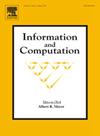树中直径不超过d的子树的精确计数:一种生成函数方法
IF 1
4区 计算机科学
Q3 COMPUTER SCIENCE, THEORY & METHODS
引用次数: 0
摘要
网络基序,被认为是基本的构建模块,为复杂网络的结构和功能提供了重要的见解,具有广泛的跨学科应用,包括社会学,计算机科学,生物信息学,化学信息学和药剂学。然而,网络基序的识别仍然是一个重要的和具有计算挑战性的问题。在各种主题中,子树枚举近年来获得了大量关注,特别是由于其在网络科学和生物信息学中的相关性。对于n顶点树T,通过引入具有(d+2)变量的新颖生成函数,我们提出了一种创新的精确枚举T的子树的算法,其中v与最远的叶子之间的距离为k=0,1,…,d,任意两个叶子之间的距离不超过d。在此算法的基础上,我们开发了一种新的递归算法,用于精确枚举T的各种直径不超过d的子树(简称DNMT-d子树)。我们应用这些算法推导了h≥2阶的满二叉树Bh中DNMT-d子树的数目,并简要讨论了一般树中DNMT-d子树的密度。我们的研究推广了Frank Ruskey在1981年关于树的子树列表和计数的工作,并使其成为我们研究的一个特例,其中d等于树的直径t。此外,我们提出的O(dn2)算法引入了在直径约束下枚举子树的新方法,并为在复杂网络中计算直径约束子图(motif)奠定了基础。本文章由计算机程序翻译,如有差异,请以英文原文为准。
Exact counting of subtrees with diameter no more than d in trees: A generating function approach
Network motifs, regarded as fundamental building blocks, offer crucial insights into the structure and function of complex networks, with broad applications across disciplines including sociology, computer science, bioinformatics, chemoinformatics, and pharmaceutics. However, the identification of network motifs remains a significant and computationally challenging problem. Among various motifs, subtree enumeration has garnered substantial attention in recent years, particularly due to its relevance in network science and bioinformatics. For an n-vertex tree T, by introducing novel generating functions with variables, we propose an innovative algorithm for the exact enumeration of T's subtrees rooted at fixed vertex v, where the distance between v and the farthest leaf is , and the distance between any two leaves is no more than d. Building on this algorithm, we develop novel recursive algorithms for exact enumerating various diameter no more than d subtrees (abbreviated as DNMT-d subtrees) of T. As applications, we apply these algorithms to derive the number of DNMT-d subtrees in a full binary tree with levels, and briefly discuss the density of DNMT-d subtrees in general trees. Our research generalizes the work of Frank Ruskey on Listing and Counting Subtrees of a Tree in 1981 and makes it a special case of our study where d equals the diameter of the tree T. Moreover, the proposed algorithms introduce new approaches for enumerating subtrees under diameter constraints and lay the groundwork for counting diameter-constrained subgraphs (motifs) in complex networks.
求助全文
通过发布文献求助,成功后即可免费获取论文全文。
去求助
来源期刊

Information and Computation
工程技术-计算机:理论方法
CiteScore
2.30
自引率
0.00%
发文量
119
审稿时长
140 days
期刊介绍:
Information and Computation welcomes original papers in all areas of theoretical computer science and computational applications of information theory. Survey articles of exceptional quality will also be considered. Particularly welcome are papers contributing new results in active theoretical areas such as
-Biological computation and computational biology-
Computational complexity-
Computer theorem-proving-
Concurrency and distributed process theory-
Cryptographic theory-
Data base theory-
Decision problems in logic-
Design and analysis of algorithms-
Discrete optimization and mathematical programming-
Inductive inference and learning theory-
Logic & constraint programming-
Program verification & model checking-
Probabilistic & Quantum computation-
Semantics of programming languages-
Symbolic computation, lambda calculus, and rewriting systems-
Types and typechecking
 求助内容:
求助内容: 应助结果提醒方式:
应助结果提醒方式:


